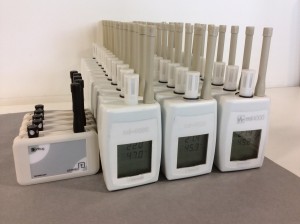Preventive conservation, and environmental monitoring in particular, is an important part of my job as Conservation Officer at the University. It was for this reason, therefore, that I found myself heading into our storage and exhibition spaces within the Centre for Research Collections, and beyond, to collect up our Hanwell environmental monitoring sensors (all 37 of them) and prepare them for their annual calibration. Although small, these sensors are invaluable in helping us to monitor temperature and relative humidity conditions, and their calibration ensures that the readings are as accurate as possible.
It is impossible to halt the aging process of a material completely. However, environmental conditions during storage and display can greatly affect the rate of aging and the extent of damage, and, therefore, a well-controlled environment can dramatically improve the condition of a collection, and reduce the need for more interventive treatment in the future. Our Hanwell environmental monitoring system provides regular readings, and helps to ensure that the conditions stay within the recommended limits as set out by the British Standard Institution’s document PD 5454:2012 (Guide for the storage and exhibition of archival material) – namely 13°C-20°C and 35%-60% relativity humidity with emphasis placed on stability within these parameters.
Having successfully undergone their yearly check-up, it was just left to place them all back again….






